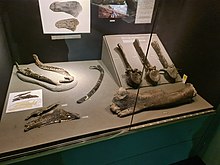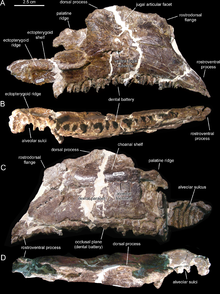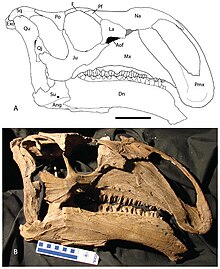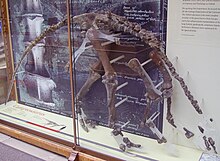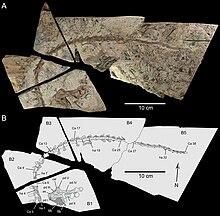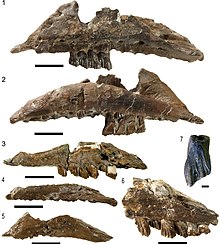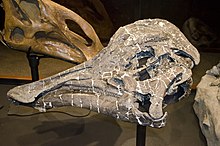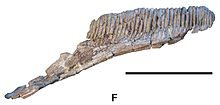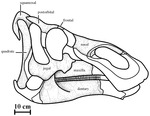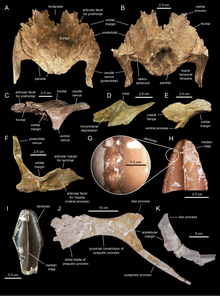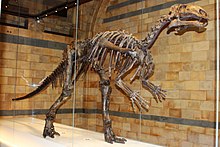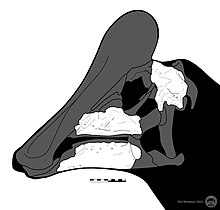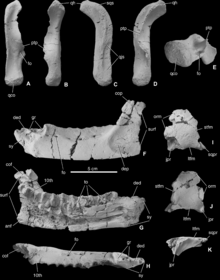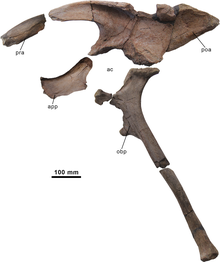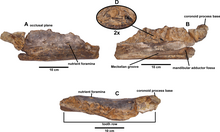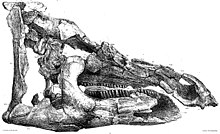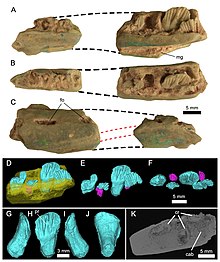List of ornithopod type specimens
This list of specimens is a comprehensive catalogue of all the type specimens and their scientific designations for each of the genera and species that are included in the clade ornithopoda.

Ornithopoda is a clade of ornithischian dinosaurs that includes some of the most common and widespread Mesozoic animals including iguanodonts, hadrosaurs, and some animals formerly called "hypsilophodonts". The clade was named by Othniel Charles Marsh in 1881[1] and roughly means "bird feet". This name is reflective of the tridactyl feet of most ornithopods, which are superficially similar to many birds. Ornithopods were among the first dinosaurs known to scientists. The first species to be described was Iguanodon, which was described in 1825 by Sir Richard Owen.[2] Today, they collectively comprise the most diverse ornithischian group.[3][4]
The exact origin of ornithopods is uncertain. Some authors consider very primitive ornithischians like Nanosaurus, Hypsilophodon, and Jeholosaurus to be ornithopods,[5] while others do not.[6] Most ornithischians were ancestrally small and bipedal, which makes the taxonomy of these species complex and uncertain.[7][8] However, they are generally agreed to have originated by the middle Jurassic and shortly thereafter, they proliferated to most of the world's continents.[9] Ornithischians in general, but especially ornithopods, saw a large degree of diversification during the early Cretaceous.[10] This culminated in the proliferation of the giant hadrosaurs across the Northern Hemisphere and even into Africa[11] and South America.[12] Ornithopod remains are known from all of the world's continents, including Antarctica.[13]
Scope and Terminology[edit]
This list will include the type fossils of each ornithopod species. In paleontology, a type specimen is one which is definitionally a member of a biological taxon. Additional specimens can only be "referred" to these taxa if an expert deems them sufficiently similar to the type and publishes that opinion in the scientific literature.
There is no complete, canonical list of all dinosaur taxa or holotype specimens. Attempts are regularly published in the form of books, such as the Princeton Field Guide to Dinosaurs by Gregory Paul[3] and Dinosaurs: The Most Complete, Up-to-Date Encyclopedia for Dinosaur Lovers of All Ages by Thomas Holtz and Luis Rey.[4] Where appropriate, The The Paleobiology Database and Fossilworks, which are both online databases of named fossil taxa, are used to supplement the entries from published encyclopedias which are missing or data-deficient.
This list will also be updated regularly as new scientific descriptions are published and new taxa are named. The most recently named ornithopod is Minqaria bata, which was described in February 2024 by Nicholas R. Longrich, Xabier Pereda-Suberbiola, Nathalie Bardet, and Nour-Eddine Jalil.[14]
Type System[edit]
Types are also used to diagnose higher-level taxa than an individual. One individual might represent the "type specimen" of a particular species. This species would in turn represent the "type species" of a particular genus, unless it is referred to a previously described genus. Most dinosaur genera are monospecific, therefore most type specimens are also the type species of their respective genera. On this list, the type species of a genus is only noted when it belongs to a genus with multiple referred species, such as Dryosaurus or Parasaurolophus. Furthermore, when an animal is different enough from its close relatives that it is given its own family, it is conventional in dinosaur systematics to name a family after the first described, most famous, or most abundant genus assigned to it. Therefore, on this list, the type species of any type genus for a family or sub-family level taxon is also noted when appropriate.
There are several different varieties of type specimen when referring to fossil animals:[15]
- Holotype: This is the most common and simplest form of type specimen. A holotype is the first material of a fossil taxon that is described in the scientific literature. In order to qualify as a true holotype, all of the fossils of the type must belong to the same individual animal. All type specimens on this list are holotypes, unless otherwise indicated.
- Paratype(s): These are described in the same publication as the holotype. A paratype is designated when the fossil material is diagnostic enough to belong to the same species as the holotype, but it is not from the same individual animal. In these cases, the holotype and paratype(s) are collectively called the "type series" for that taxon. On this list, paratypes are noted in the same entry as their associated holotype.
- Neotype: When a holotype specimen is lost, destroyed, or otherwise unable to be studied further by scientists, a new type specimen for that taxon is required in order to identify future material. On this list, neotypes are only given their own entries when the holotype was never formally given a specimen number, otherwise they are noted in the entry for the holotype.
- Syntype(s): This is a type series in which no single specimen is selected to serve as a holotype, nor are any designated as paratypes. This is typically done if the fossil material is believed to be from multiple animals, but none of the individual animals were well-preserved enough to provide a complete list of diagnostic characters. These are also sometimes called "cotypes" in publications, although this is discouraged by the ICZN.
- Lectotype: When a single type specimen from a series of syntypes is designated as the new primary type specimen in a subsequent publication, this is considered to be a lectotype. On this list, lectotypes are given their own entries.
- Paralectotype(s): When a lectotype is designated from a series of syntypes, the remaining syntypes become paralectotypes as part of a reorganized type series. On this list, paralectotypes are noted alongside the list entry for the lectotype of their respective series.
- Plastotype: Sometimes, if a cast of a type specimen is made and the original type specimen is lost or destroyed, the cast can be used for the purposes of diagnostic referral to a taxon. Plastotypes are only given their own entries on this list if the holotype was not given a specimen number. Otherwise, they are noted alongside the entry for the holotype.
- Topotype: When a specimen is discovered from the same locality as a holotype specimen it may be given a new specimen number. If the second specimen is later determined to belong to the same animal as the holotype after the holotype has been described, it becomes a topotype.
All name-bearing type specimens (i.e. holotypes, lectotypes, neotypes, and syntypes) have unique entries on this list, and non-name-bearing types (i.e. paratypes, paralectotypes, topotypes, and holotypes that have been subsumed by a neotype) are noted alongside their name-bearing counterpart.
Validity[edit]
Some described species are later determined to be invalid by subsequent scientific publications. However, invalid species are sometimes resurrected, such as in the case of Brontosaurus,[16] and sometimes the validity of a species can be controversial among researchers (e.g. the case of Torosaurus and Triceratops[17][18]). For the purposes of neutrality and completeness, all described species and genera of marginocephalians are included, even those that have been considered invalid in subsequent scientific publications.
Naming conventions and terminology follow the International Code of Zoological Nomenclature (ICZN).[15] Technical terms used include:
- Junior synonym: A name which describes the same taxon as a previously published name. If two or more taxa are formally designated and the type specimens are later assigned to the same taxon, the first to be published (in chronological order) is the senior synonym, and all other instances are junior synonyms. Senior synonyms are generally used, except by special decision of the ICZN, but junior synonyms cannot be used again, even if deprecated. Junior synonymy is often subjective, unless the genera described were both based on the same type specimen.
- Nomen dubium (Latin for "dubious name"): A name describing a fossil with no unique diagnostic features. T his can be an extremely controversial designation, and as such, they are only notated when their supposedly dubious status has been formally published. Furthermore, if the scientific community has yet to reach a consensus on the validity of a name or taxon, the ongoing nature of the controversy will be stated.
- Nomen nudum (Latin for "naked name"): A name that has appeared in print but has not yet been formally published by the standards of the ICZN. Nomina nuda (the plural form) are invalid, and are not included on this list.
- Preoccupied name: A name that is formally published, but which has already been used for another taxon. This second use is invalid (as are all subsequent uses) and the name must be replaced.
Omissions[edit]
Some ornithopod taxa are not included on this list. Nomina nuda are not included because a type does not become recognized by the ICZN until it is published in a scientific journal with a full description.
Some misidentified taxa are also not included so long as there is a scientific consensus with regard to the specimen in question. If a specimen is later referred to a taxon outside ornithopoda, it is not included on this list. However, specimens that are identified as ornithopods in publications subsequent to their initial description are included under the name they are given within ornithopoda.
Referred taxa are only included on the list as separate entries when their initial description includes a unique type specimen.
In the case of specimens with uncertain taxonomic affinity, they will be excluded unless they are considered ornithopods by the most recently published nomenclatural study of ornithischian dinosaurs, published in 2021.[8] This excludes animals like Jeholosaurus and Thescelosaurus, which are considered basal neornithischians by the authors. This is the same definition used on the article "Ornithopoda".
List of Specimens[edit]
- Binomial name: All animals species are given a unique binomial name, typically consisting of Latin or Greek words which are used to formally and scientifically identify each species.
- Catalogue number: In most museum collections, each fossil specimen will be given a unique catalogue number which is published with the description of the fossils after they are prepared. This serves as a formal name for every single described fossil so that authors are able to refer to individual fossil discoveries in the scientific literature by name.
- Institution: Most published fossils are stored in museum collections or at universities. This is also true of type specimens, many of which are on display in museums around the world. If a type specimen has been lost, the last known location of the type is listed.
- Age: The geological stage from which the specimen was recovered is listed, when it is known. The exact age of some geological formations is not known. If this is the case, a range of possible ages is given.
- Unit: Most fossils are recovered from named geologic formations (e.g. the Morrison Formation or the Hell Creek Formation). When this is not the case, a city or landmark near the locality from which the fossil was recovered is listed.
- Material: The vast majority of fossils do not preserve the complete skeleton of an animal. In these cases, the specific bones which are fossilized have been listed.
- Notes: Other general information, such as the validity status of the taxon in question, or any other material in the type series may be listed here.
See also[edit]
- List of marginocephalian type specimens
- List of thyreophoran type specimens
- List of other ornithischian type specimens
- List of non-avian theropod type specimens
- List of sauropodomorph type specimens
- List of Mesozoic birds
References[edit]
- ^ Marsh, O. C. (1882). "Classification of the Dinosauria". American Journal of Science. 23 (133): 81–86. Bibcode:1882AmJS...23...81M. doi:10.2475/ajs.s3-23.133.81. S2CID 130836648.
- ^ Lucas, Spencer G.; Dean, Dennis R. (December 1999). "Book review: Gideon Mantell and the discovery of dinosaurs". PALAIOS. 14 (6): 601–602. Bibcode:1999Palai..14..601L. doi:10.2307/3515316. ISSN 0883-1351. JSTOR 3515316.
- ^ a b Paul, G. S. (2010). The Princeton Field Guide to Dinosaurs. Princeton University Press. ISBN 978-0-691-13720-9.
- ^ a b Hotlz, Dr. Thomas R. (2007). Dinosaurs: The Most Complete, Up-to-Date Encyclopedia for Dinosaur Lovers of All Ages. Rey, Luis V. Random House Books for Young Readers. ISBN 978-0375824197.
- ^ Dieudonné, P. -E.; Cruzado-Caballero, P.; Godefroit, P.; Tortosa, T. (2021). "A new phylogeny of cerapodan dinosaurs". Historical Biology. 33 (10): 2335–2355. doi:10.1080/08912963.2020.1793979. S2CID 221854017.
- ^ Madzia, Daniel; Boyd, Clint A.; Mazuch, Martin (2017). "A basal ornithopod dinosaur from the Cenomanian of the Czech Republic". Journal of Systematic Palaeontology. 16 (11): 967–979. doi:10.1080/14772019.2017.1371258. S2CID 90008574.
- ^ Ibiricu, Lucio M.; Martínez, Rubén D.; Lamanna, Matthew C.; Casal, Gabriel A.; Luna, Marcelo; Harris, Jerald D.; Lacovara, Kenneth J. (2010). "A Medium-Sized Ornithopod (Dinosauria: Ornithischia) from the Upper Cretaceous Bajo Barreal Formation of Lago Colhué Huapi, Southern Chubut Province, Argentina". Annals of Carnegie Museum. 79: 39–50. doi:10.2992/007.079.0103. S2CID 53407321.
- ^ a b Madzia, D.; Arbour, V.M.; Boyd, C.A.; Farke, A.A.; Cruzado-Caballero, P.; Evans, D.C. (2021). "The phylogenetic nomenclature of ornithischian dinosaurs". PeerJ. 9: e12362. doi:10.7717/peerj.12362. PMC 8667728. PMID 34966571.
- ^ Rotatori, Filippo Maria; Moreno-Azanza, Miguel; Mateus, Octávio (2020). "New information on ornithopod dinosaurs from the Late Jurassic of Portugal". Acta Palaeontologica Polonica. 65. doi:10.4202/app.00661.2019. hdl:10362/127574. S2CID 146510209.
- ^ Medrano-Aguado, E.; Parrilla-Bel, J.; Gasca, J.M.; Alonso, A.; Canudo, J.I. (2023). "Ornithopod diversity in the Lower Cretaceous of Spain: New styracosternan remains from the Barremian of the Maestrazgo Basin (Teruel province, Spain)". Cretaceous Research. 144: 105458. Bibcode:2023CrRes.14405458M. doi:10.1016/j.cretres.2022.105458. S2CID 255177225.
- ^ a b c d e Longrich, Nicholas R.; Suberbiola, Xabier Pereda; Pyron, R. Alexander; Jalil, Nour-Eddine (2021-04-01). "The first duckbill dinosaur (Hadrosauridae: Lambeosaurinae) from Africa and the role of oceanic dispersal in dinosaur biogeography". Cretaceous Research. 120: 104678. Bibcode:2021CrRes.12004678L. doi:10.1016/j.cretres.2020.104678. ISSN 0195-6671. S2CID 228807024.
- ^ Brett-Surman, M. K. (1979). "Phylogeny and palaeobiogeography of hadrosaurian dinosaurs". Nature. 277 (5697): 560–562. Bibcode:1979Natur.277..560B. doi:10.1038/277560a0. S2CID 4332144.
- ^ Olivero, E.B.; Ponce, J.J.; Marsicano, C.A.; Martinioni, D.R. (2007). "Depositional settings of the basal Lopez de Bertodano Formation, Maastrichtian, Antarctica". Revista de la Asociación Geológica Argentina. 62 (4): 521–529.
- ^ a b c d e Longrich, N. R.; Pereda-Suberbiola, X.; Bardet, N.; Jalil, N.-E. (2024). "A new small duckbilled dinosaur (Hadrosauridae: Lambeosaurinae) from Morocco and dinosaur diversity in the late Maastrichtian of North Africa". Scientific Reports. 14 (1). 3665. doi:10.1038/s41598-024-53447-9. PMC 10864364. PMID 38351204.
- ^ a b "ICZN Code Art. 5". Archived from the original on 2016-12-20. Retrieved 2016-12-09.
- ^ Tschopp, E.; Mateus, O. V.; Benson, R. B. J. (2015). "A specimen-level phylogenetic analysis and taxonomic revision of Diplodocidae (Dinosauria, Sauropoda)". PeerJ. 3: e857. doi:10.7717/peerj.857. PMC 4393826. PMID 25870766.

- ^ Scannella, J.; Horner, J.R. (2010). "Torosaurus Marsh, 1891, is Triceratops Marsh, 1889 (Ceratopsidae: Chasmosaurinae): synonymy through ontogeny". Journal of Vertebrate Paleontology. 30 (4): 1157–1168. Bibcode:2010JVPal..30.1157S. doi:10.1080/02724634.2010.483632. S2CID 86767957.
- ^ Longrich, Nicholas R.; Field, Daniel J. (February 29, 2012). "Torosaurus Is Not Triceratops: Ontogeny in Chasmosaurine Ceratopsids as a Case Study in Dinosaur Taxonomy". PLOS ONE. 7 (2): e32623. Bibcode:2012PLoSO...732623L. doi:10.1371/journal.pone.0032623. ISSN 1932-6203. PMC 3290593. PMID 22393425.
- ^ a b c Gates, Terry A.; Horner, John R.; Hanna, Rebecca R.; Nelson, C. Riley (2011). "New unadorned hadrosaurine hadrosaurid (Dinosauria, Ornithopoda) from the Campanian of North America". Journal of Vertebrate Paleontology. 31 (4): 798–811. Bibcode:2011JVPal..31..798G. doi:10.1080/02724634.2011.577854. ISSN 0272-4634. S2CID 8878474.
- ^ Jinnah, Zubair A.; Roberts, Eric M.; Deino, Alan L.; Larsen, Joseph S.; Link, Paul K.; Fanning, C. Mark (2009-04-01). "New 40Ar-39Ar and detrital zircon U-Pb ages for the Upper Cretaceous Wahweap and Kaiparowits formations on the Kaiparowits Plateau, Utah: implications for regional correlation, provenance, and biostratigraphy". Cretaceous Research. 30 (2): 287–299. Bibcode:2009CrRes..30..287J. doi:10.1016/j.cretres.2008.07.012. ISSN 0195-6671.
- ^ a b c d Gates, Terry A., Zubair Jinnah, Carolyn Levitt, Michael A. Getty, D. A. Eberth, and D. C. Evans. "New hadrosaurid (Dinosauria, Ornithopoda) specimens from the lower-middle Campanian Wahweap Formation of southern Utah." Hadrosaurs (2014): 156-173.
- ^ a b c d e Prieto-Márquez, Albert; Fondevilla, Víctor; Sellés, Albert G.; Wagner, Jonathan R.; Galobart, Àngel (2019-04-01). "Adynomosaurus arcanus, a new lambeosaurine dinosaur from the Late Cretaceous Ibero-Armorican Island of the European archipelago". Cretaceous Research. 96: 19–37. Bibcode:2019CrRes..96...19P. doi:10.1016/j.cretres.2018.12.002. ISSN 0195-6671. S2CID 134582286.
- ^ a b c d Norman, David B. (1998). "On Asian ornithopods (Dinosauria: Ornithischia). 3. A new species of iguanodontid dinosaur". Zoological Journal of the Linnean Society. 122 (1–2): 291–348. doi:10.1111/j.1096-3642.1998.tb02533.x. ISSN 0024-4082.
- ^ a b c d Godefroit, Pascal, Yuri L. Bolotsky, and Jimmy Van Itterbeeck. "The lambeosaurine dinosaur Amurosaurus riabinini, from the Maastrichtian of Far Eastern Russia." Acta Palaeontologica Polonica 49, no. 4 (2004).
- ^ a b c d Coria, Rodolfo A.; Calvo, Jorge O. (2002-09-19). "A new iguanodontian ornithopod from Neuquen Basin, Patagonia, Argentina". Journal of Vertebrate Paleontology. 22 (3): 503–509. doi:10.1671/0272-4634(2002)022[0503:ANIOFN]2.0.CO;2. ISSN 0272-4634. S2CID 130811777.
- ^ a b c d Hunt, Adrian P.; Lucas, Spencer G. (1993). "Cretaceous vertebrates of New Mexico". In Lucas, S.G.; Zidek, J. (eds.). Dinosaurs of New Mexico. New Mexico Museum of Natural History and Science Bulletin, 2. Albuquerque, New Mexico: New Mexico Museum of Natural History and Science. pp. 77–91.
- ^ a b c d Wagner, Jonathan R.; Lehman, Thomas M. (2009-06-12). "An enigmatic new lambeosaurine hadrosaur (Reptilia: Dinosauria) from the Upper Shale member of the Campanian Aguja Formation of Trans-Pecos Texas". Journal of Vertebrate Paleontology. 29 (2): 605–611. Bibcode:2009JVPal..29..605W. doi:10.1671/039.029.0208. ISSN 0272-4634. S2CID 128555861.
- ^ a b c d Prieto-Márquez, Albert; Wagner, Jonathan R.; Lehman, Thomas (2020-03-18). "An unusual 'shovel-billed' dinosaur with trophic specializations from the early Campanian of Trans-Pecos Texas, and the ancestral hadrosaurian crest". Journal of Systematic Palaeontology. 18 (6): 461–498. doi:10.1080/14772019.2019.1625078. ISSN 1477-2019. S2CID 202018197.
- ^ a b c d Godefroit, Pascal, Vladimir Alifanov, and Yuri Bolotsky. "A re-appraisal of Aralosaurus tuberiferus (Dinosauria, Hadrosauridae) from the Late Cretaceous of Kazakhstan." Bulletin de l’Institut royal des Sciences naturelles de Belgique, Sciences de la Terre74 (2004): 139-154.
- ^ a b c d Pereda-Suberbiola, Xabier; Canudo, José Ignacio; Cruzado-Caballero, Penélope; Barco, José Luis; López-Martínez, Nieves; Oms, Oriol; Ruiz-Omeñaca, José Ignacio (2009). "The last hadrosaurid dinosaurs of Europe: A new lambeosaurine from the Uppermost Cretaceous of Aren (Huesca, Spain)". Comptes Rendus Palevol. 8 (6): 559–572. Bibcode:2009CRPal...8..559P. doi:10.1016/j.crpv.2009.05.002.
- ^ a b c d e Norman, David B.; Kurzanov, Sergei M. (1997-01-01). "On Asian ornithopods (Dinosauria: Ornithischia). 2. Arstanosaurus akkurganensis Shilin and Suslov, 1982". Proceedings of the Geologists' Association. 108 (3): 191–199. Bibcode:1997PrGA..108..191N. doi:10.1016/S0016-7878(97)80027-2. ISSN 0016-7878.
- ^ a b c d e f g h i j k l Herne, Matthew C.; Nair, Jay P.; Evans, Alistair R.; Tait, Alan M. (2019-03-11). "New small-bodied ornithopods (Dinosauria, Neornithischia) from the Early Cretaceous Wonthaggi Formation (Strzelecki Group) of the Australian-Antarctic rift system, with revision of Qantassaurus intrepidus Rich and Vickers-Rich, 1999". Journal of Paleontology. 93 (3): 543–584. Bibcode:2019JPal...93..543H. doi:10.1017/jpa.2018.95. ISSN 0022-3360. S2CID 134593160.
- ^ Prieto-Márquez, Albert; Wagner, Jonathan R.; Bell, Phil R.; Chiappe, Luis M. (2014-07-09). "The late-surviving 'duck-billed' dinosaur Augustynolophus from the upper Maastrichtian of western North America and crest evolution in Saurolophini". Geological Magazine. 152 (2): 225–241. doi:10.1017/S0016756814000284. ISSN 0016-7568. S2CID 131049979.
- ^ a b c Prieto-Márquez, Albert; Wagner, Jonathan (2011). "Saurolophus morrisi, a new species of hadrosaurid dinosaur from the Late Cretaceous of the Pacific coast of North America". Acta Palaeontologica Polonica. doi:10.4202/app.2011.0049. ISSN 0567-7920. S2CID 55969908.
- ^ a b c d Prieto-Márquez, Albert (2011). "Cranial and appendicular ontogeny of Bactrosaurus johnsoni, a hadrosauroid dinosaur from the Late Cretaceous of northern China: ONTOGENY OF BACTROSAURUS". Palaeontology. 54 (4): 773–792. doi:10.1111/j.1475-4983.2011.01053.x. S2CID 83772276.
- ^ a b c d e f g h Norman, David B. (2010-05-31). "A taxonomy of iguanodontians (Dinosauria: Ornithopoda) from the lower Wealden Group (Cretaceous: Valanginian) of southern England". Zootaxa. 2489 (1): 47. doi:10.11646/zootaxa.2489.1.3. ISSN 1175-5334.
- ^ a b c d "First lambeosaurine dinosaur from the Nemegt Formation, Mongolia - Acta Palaeontologica Polonica". www.app.pan.pl. Retrieved 2022-08-23.
- ^ a b c d Godefroit, Pascal, François Escuillié, Yuri L. Bolotsky, and Pascaline Lauters. "A new basal hadrosauroid dinosaur from the Upper Cretaceous of Kazakhstan." Bernissart dinosaurs and Early Cretaceous terrestrial ecosystems (2012): 335-358.
- ^ a b c d Xu, Xing; Tan, Qingwei; Gao, Yilong; Bao, Zhiqiang; Yin, Zhigang; Guo, Bin; Wang, Junyou; Tan, Lin; Zhang, Yuguang; Xing, Hai (2018-05-15). "A large-sized basal ankylopollexian from East Asia, shedding light on early biogeographic history of Iguanodontia". Science Bulletin. 63 (9): 556–563. Bibcode:2018SciBu..63..556X. doi:10.1016/j.scib.2018.03.016. PMID 36658842. S2CID 104031324.
- ^ a b c d Cruzado-Caballero, Penelope; Pereda-Suberbiola, Xabier; Ruiz-Omeñaca, J. Ignacio (2010-11-12). Sues, Hans (ed.). "Blasisaurus canudoi gen. et sp. nov., a new lambeosaurine dinosaur (Hadrosauridae) from the Latest Cretaceous of Arén (Huesca, Spain)". Canadian Journal of Earth Sciences. 47 (12): 1507–1517. Bibcode:2010CaJES..47.1507S. doi:10.1139/E10-081. ISSN 0008-4077.
- ^ a b Wenhao, Wu, and Pascal Godefroit. "Anatomy and relationships of Bolong yixianensis, an Early Cretaceous iguanodontid dinosaur from western Liaoning, China." Bernissart dinosaurs and Early Cretaceous terrestrial ecosystems 293 (2012): 293-333.
- ^ Zhong, Yuting; Huyskens, Magdalena H; Yin, Qing-Zhu; Wang, Yaqiong; Ma, Qiang; Xu, Yi-Gang (2021-06-12). "High-precision geochronological constraints on the duration of 'Dinosaur Pompeii' and the Yixian Formation". National Science Review. 8 (6): nwab063. doi:10.1093/nsr/nwab063. ISSN 2095-5138. PMC 8288181. PMID 34691675.
- ^ a b "辽宁义县组禽龙类恐龙一新属种——义县薄氏龙Bolong yixianensis gen. et sp. nov. - 中国知网". www.cnki.net. doi:10.13686/j.cnki.dzyzy.2010.02.001. Retrieved 2022-08-24.
- ^ a b c d Cruzado-Caballero, Penélope; Powell, Jaime (2017-03-04). "Bonapartesaurus rionegrensis , a new hadrosaurine dinosaur from South America: implications for phylogenetic and biogeographic relations with North America". Journal of Vertebrate Paleontology. 37 (2): e1289381. Bibcode:2017JVPal..37E9381C. doi:10.1080/02724634.2017.1289381. hdl:11336/57944. ISSN 0272-4634. S2CID 90963879.
- ^ a b c d e f g h Fowler, Elizabeth A. Freedman; Horner, John R. (2015-11-11). "A New Brachylophosaurin Hadrosaur (Dinosauria: Ornithischia) with an Intermediate Nasal Crest from the Campanian Judith River Formation of Northcentral Montana". PLOS ONE. 10 (11): e0141304. Bibcode:2015PLoSO..1041304F. doi:10.1371/journal.pone.0141304. ISSN 1932-6203. PMC 4641681. PMID 26560175.
- ^ a b c d Lockwood, Jeremy A. F.; Martill, David M.; Maidment, Susannah C. R. (2021-06-18). "A new hadrosauriform dinosaur from the Wessex Formation, Wealden Group (Early Cretaceous), of the Isle of Wight, southern England". Journal of Systematic Palaeontology. 19 (12): 847–888. doi:10.1080/14772019.2021.1978005. ISSN 1477-2019. S2CID 244067410.
- ^ a b c d Madzia, Daniel; Boyd, Clint A.; Mazuch, Martin (2018-09-02). "A basal ornithopod dinosaur from the Cenomanian of the Czech Republic". Journal of Systematic Palaeontology. 16 (11): 967–979. doi:10.1080/14772019.2017.1371258. ISSN 1477-2019. S2CID 90008574.
- ^ a b c d Ruiz-Omeñaca, José Ignacio; Suberbiola, Xabier Pereda; Galton, Peter M., "Callovosaurus leedsi, the Earliest Dryosaurid Dinosaur (Ornithischia: Euornithopoda) from the Middle Jurassic of England", Horns and Beaks, Indiana University Press, pp. 3–16, doi:10.2307/j.ctt1zxz1md.6, retrieved 2022-08-27
- ^ a b c d e Prieto-Márquez, Albert; Sellés, Albert (2023). "Evolutionary convergence in a small cursorial styracosternan ornithopod dinosaur from western Europe". Journal of Vertebrate Paleontology. 42 (5). doi:10.1080/02724634.2023.2210632.
- ^ a b Galton, Peter M., "Teeth of Ornithischian Dinosaurs (Mostly Ornithopoda) from the Morrison Formation (Upper Jurassic) of the Western United States", Horns and Beaks, Indiana University Press, pp. 17–48, doi:10.2307/j.ctt1zxz1md.7, retrieved 2022-08-27
- ^ a b Marsh, Othniel Charles (1879-12-01). "Notice of new Jurassic reptiles". American Journal of Science. s3-18 (108): 501–505. Bibcode:1879AmJS...18..501M. doi:10.2475/ajs.s3-18.108.501. ISSN 0002-9599. S2CID 131001110.
- ^ a b c d Prieto-Márquez, Albert; Dalla Vecchia, Fabio M.; Gaete, Rodrigo; Galobart, Àngel (2013-07-26). Dodson, Peter (ed.). "Diversity, Relationships, and Biogeography of the Lambeosaurine Dinosaurs from the European Archipelago, with Description of the New Aralosaurin Canardia garonnensis". PLOS ONE. 8 (7): e69835. Bibcode:2013PLoSO...869835P. doi:10.1371/journal.pone.0069835. ISSN 1932-6203. PMC 3724916. PMID 23922815.
- ^ a b c d Gilpin, David; DiCroce, Tony; Carpenter, Kenneth, "A Possible New Basal Hadrosaur from the Lower Cretaceous Cedar Mountain Formation of Eastern Utah", Horns and Beaks, Indiana University Press, pp. 79–90, doi:10.2307/j.ctt1zxz1md.10, retrieved 2022-08-27
- ^ a b c d Yang, Yuqing; Wu, Wenhao; Dieudonné, Paul-Emile; Godefroit, Pascal (2020-09-08). "A new basal ornithopod dinosaur from the Lower Cretaceous of China". PeerJ. 8: e9832. doi:10.7717/peerj.9832. ISSN 2167-8359. PMC 7485509. PMID 33194351.
- ^ a b c d e f Godefroit, Pascal; Zan, Shuqin; Jin, Liyong (2000-06-30). "Charonosaurus jiayinensis n.g., n.sp.,a lambeosaurine dinosaur from the Late Maastrichtian of northeastern China". Comptes Rendus de l'Académie des Sciences - Series IIA - Earth and Planetary Science. 330 (12): 875–882. Bibcode:2000CRASE.330..875G. doi:10.1016/S1251-8050(00)00214-7. ISSN 1251-8050.
- ^ a b c d Gates, Terry A.; Tsogtbaatar, Khishigjav; Zanno, Lindsay E.; Chinzorig, Tsogtbaatar; Watabe, Mahito (2018-08-03). "A new iguanodontian (Dinosauria: Ornithopoda) from the Early Cretaceous of Mongolia". PeerJ. 6: e5300. doi:10.7717/peerj.5300. ISSN 2167-8359. PMC 6078070. PMID 30083450.
- ^ a b c d Carpenter, Kenneth; Young, D. Bruce (2002-01-01). "Late Cretaceous dinosaurs from the Denver Basin, Colorado". Rocky Mountain Geology. 37 (2): 237–254. doi:10.2113/gsrocky.37.2.237. Retrieved 2022-08-27.
- ^ a b c d Prieto-Márquez, Albert; Erickson, Gregory M.; Ebersole, Jun A. (2016-04-14). "Anatomy and osteohistology of the basal hadrosaurid dinosaur Eotrachodon from the uppermost Santonian (Cretaceous) of southern Appalachia". PeerJ. 4: e1872. doi:10.7717/peerj.1872. ISSN 2167-8359. PMC 4841272. PMID 27114863.
- ^ a b c d Andrzejewski, Kate A.; Winkler, Dale A.; Jacobs, Louis L. (2019-03-12). Forster, Catherine (ed.). "A new basal ornithopod (Dinosauria: Ornithischia) from the Early Cretaceous of Texas". PLOS ONE. 14 (3): e0207935. Bibcode:2019PLoSO..1407935A. doi:10.1371/journal.pone.0207935. ISSN 1932-6203. PMC 6413910. PMID 30860999.
- ^ a b c d Brown, Barnum (1914). Corythosaurus casuarius, a new crested dinosaur from the Belly River Cretaceous : with Provisional classification of the family Trachodontidae. [Published by order of the Trustees, American Museum of Natural History]. OCLC 31841239.
- ^ a b Martill, David M., Darren Naish, and S. Earland. "Dinosaurs in marine strata: evidence from the British Jurassic, including a review of the allochthonous vertebrate assemblage from the marine Kimmeridge Clay Formation (Upper Jurassic) of Great Britain." Actas de las III Jornadas Intrernacionales sobre Paleontologýá de Dinosaurios y su Entorno, 16–17 September 2004 (2006): 47-84.
- ^ a b Hulke, J. W. (1880). "Iguanodon Prestwichii, a new Species from the Kimmeridge Clay, distinguished from I. Mantelli of the Wealden Formation in the S.E. of England and Isle of Wight by Differences in the Shape of the Vertebral Centra, by fewer than five Sacral Vertebrœ, by the simpler Character of its Tooth-serrature, &·c., founded on numerous fossil remains lately discovered at Cumnor, near Oxford". Quarterly Journal of the Geological Society. 36 (1–4): 433–456. doi:10.1144/gsl.jgs.1880.036.01-04.36. Retrieved 2022-08-27.
- ^ a b c d Weishampel, David B.; Bjork, Philip R. (1989-03-30). "The first indisputable remains of Iguanodon (Ornithischia: Ornithopoda) from North America: Iguanodon lakotaensis , sp. nov". Journal of Vertebrate Paleontology. 9 (1): 56–66. Bibcode:1989JVPal...9...56W. doi:10.1080/02724634.1989.10011738. ISSN 0272-4634.
- ^ a b c d e f g h i j k l m n Norman, David B. "On the taxonomy and diversity of Wealden iguanodontian dinosaurs (Ornithischia: Ornithopoda)." Revue de Paléobiologie 32, no. 2 (2013): 385-404.
- ^ a b c d Xu, S. C., H. L. You, J. W. Wang, S. Z. Wang, J. Yi, and L. Jia. "A new hadrosauroid dinosaur from the Late Cretaceous of Tianzhen, Shanxi Province, China." Vertebrata PalAsiatica 54, no. 1 (2016): 67-78.
- ^ a b c d Ruiz-Omeñaca, J. I. (2011-06-30). "<i>Delapparentia turolensis</i> nov. gen et sp., un nuevo dinosaurio iguanodontoideo (Ornithischia: Ornithopoda) en el Cretácico Inferior de Galve". Estudios Geológicos. 67 (1): 83. doi:10.3989/egeol.40276.124. ISSN 1988-3250.
- ^ a b c Coombs Jr, Walter P. "The status of the dinosaurian genus Diclonius and the taxonomic utility of hadrosaurian teeth." Journal of Paleontology (1988): 812-817.
- ^ Fowler, Denver Warwick (2017-11-22). Wong, William Oki (ed.). "Revised geochronology, correlation, and dinosaur stratigraphic ranges of the Santonian-Maastrichtian (Late Cretaceous) formations of the Western Interior of North America". PLOS ONE. 12 (11): e0188426. Bibcode:2017PLoSO..1288426F. doi:10.1371/journal.pone.0188426. ISSN 1932-6203. PMC 5699823. PMID 29166406.
- ^ Cope, Edward D. "Descriptions of some vertebrate remains from the Fort Union beds of Montana." Proceedings of the Academy of Natural Sciences of Philadelphia (1876): 248-261.
- ^ a b c d Herne, Matthew C.; Tait, Alan M.; Weisbecker, Vera; Hall, Michael; Nair, Jay P.; Cleeland, Michael; Salisbury, Steven W. (2018-01-11). "A new small-bodied ornithopod (Dinosauria, Ornithischia) from a deep, high-energy Early Cretaceous river of the Australian–Antarctic rift system". PeerJ. 5: e4113. doi:10.7717/peerj.4113. ISSN 2167-8359. PMC 5767335. PMID 29340228.
- ^ a b c Mateus, Octávio; Telles Antunes, Miguel (2001-01-01). "Draconyx loureiroi, a new camptosauridae (Dinosauria, Ornithopoda) from the Late Jurassic of Lourinhã, Portugal". Annales de Paléontologie. 87 (1): 61–73. Bibcode:2001AnPal..87...61M. doi:10.1016/S0753-3969(01)88003-4. ISSN 0753-3969.
- ^ Waskow, Katja; Mateus, Octavio (2017-06-01). "Dorsal rib histology of dinosaurs and a crocodylomorph from western Portugal: Skeletochronological implications on age determination and life history traits". Comptes Rendus Palevol. 16 (4): 425–439. Bibcode:2017CRPal..16..425W. doi:10.1016/j.crpv.2017.01.003. ISSN 1631-0683.
- ^ a b c d Galton, Peter M. (1981). "Dryosaurus, a hypsilophodontid dinosaur from the upper jurassic of north America and Africa postcranial skeleton". Paläontologische Zeitschrift. 55 (3–4): 271–312. doi:10.1007/bf02988144. ISSN 0031-0220. S2CID 129591644.
- ^ a b c d Carpenter, Kenneth; Galton, Peter (2018-08-17). "A photo documentation of bipedal ornithischian dinosaurs from the Upper Jurassic Morrison Formation, USA". Geology of the Intermountain West. 5: 167–207. doi:10.31711/giw.v5.pp167-207. ISSN 2380-7601. S2CID 73691452.
- ^ a b c Hubner, Tom R.; Rauhaut, Oliver W. M. (2010-08-16). "A juvenile skull of Dysalotosaurus lettowvorbecki (Ornithischia: Iguanodontia), and implications for cranial ontogeny, phylogeny, and taxonomy in ornithopod dinosaurs". Zoological Journal of the Linnean Society. 160 (2): 366–396. doi:10.1111/j.1096-3642.2010.00620.x. ISSN 0024-4082. S2CID 84109541.
- ^ a b c Galton, Peter M. "The posture of hadrosaurian dinosaurs." Journal of Paleontology (1970): 464-473.
- ^ a b c d e Xing, Hai; Mallon, Jordan C.; Currie, Margaret L. (2017-04-06). "Supplementary cranial description of the types of Edmontosaurus regalis (Ornithischia: Hadrosauridae), with comments on the phylogenetics and biogeography of Hadrosaurinae". PLOS ONE. 12 (4): e0175253. Bibcode:2017PLoSO..1275253X. doi:10.1371/journal.pone.0175253. ISSN 1932-6203. PMC 5383305. PMID 28384240.
- ^ a b c d e f g h Galton, Peter M.; Taquet, Philippe (1982-01-01). "Valdosaurus, a hypsilophodontid dinosaur from the Lower Cretaceous of Europe and Africa". Geobios. 15 (2): 147–159. Bibcode:1982Geobi..15..147G. doi:10.1016/S0016-6995(82)80017-X. ISSN 0016-6995.
- ^ a b c d Kirkland, J. I. "A new hadrosaurid from the upper Cedar Mountain Formation (Albian-Cenomanian: Cretaceous) of eastern Utah–the oldest known hadrosaurid (lambeosaurine?)." New Mexico Museum of Natural History and Science Bulletin 14 (1998): 283-295.
- ^ a b c d Prieto-Marquez, Albert; Erickson, Gregory M.; Ebersole, Jun A. (2016-03-03). "A primitive hadrosaurid from southeastern North America and the origin and early evolution of 'duck-billed' dinosaurs". Journal of Vertebrate Paleontology. 36 (2): e1054495. Bibcode:2016JVPal..36E4495P. doi:10.1080/02724634.2015.1054495. ISSN 0272-4634. S2CID 86032549.
- ^ a b c d Escaso, Fernando; Ortega, Francisco; Dantas, Pedro; Malafaia, Elisabete; Silva, Bruno; Gasulla, José M.; Mocho, Pedro; Narváez, Iván; Sanz, JosÉ L. (2014-07-29). "A new dryosaurid ornithopod (Dinosauria, Ornithischia) from the Late Jurassic of Portugal". Journal of Vertebrate Paleontology. 34 (5): 1102–1112. Bibcode:2014JVPal..34.1102E. doi:10.1080/02724634.2014.849715. ISSN 0272-4634. S2CID 86780835.
- ^ a b c d You, Hai-lu; Luo, Zhe-xi; Shubin, Neil H.; Witmer, Lawrence M.; Tang, Zhi-lu; Tang, Feng (2003-06-01). "The earliest-known duck-billed dinosaur from deposits of late Early Cretaceous age in northwest China and hadrosaur evolution". Cretaceous Research. 24 (3): 347–355. Bibcode:2003CrRes..24..347Y. doi:10.1016/S0195-6671(03)00048-X. ISSN 0195-6671.
- ^ a b c d e f g h i Barrett, Paul M.; Bonsor, Joseph A. (2021-02-01). "A revision of the non-avian dinosaurs 'Eucercosaurus tanyspondylus' and 'Syngonosaurus macrocercus' from the Cambridge Greensand, UK". Cretaceous Research. 118: 104638. Bibcode:2021CrRes.11804638B. doi:10.1016/j.cretres.2020.104638. ISSN 0195-6671. S2CID 225289654.
- ^ a b c d Bell, Phil R.; Brougham, Tom; Herne, Matthew C.; Frauenfelder, Timothy; Smith, Elizabeth T. (2019-01-02). "Fostoria dhimbangunmal, gen. et sp. nov., a new iguanodontian (Dinosauria, Ornithopoda) from the mid-Cretaceous of Lightning Ridge, New South Wales, Australia". Journal of Vertebrate Paleontology. 39 (1): e1564757. Bibcode:2019JVPal..39E4757B. doi:10.1080/02724634.2019.1564757. ISSN 0272-4634. S2CID 195424096.
- ^ a b c d Kobayashi, Yoshitsugu; Azuma, Yoichi (2003-04-11). "A new iguanodontian (Dinosauria: Ornithopoda) from the Lower Cretaceous Kitadani Formation of Fukui Prefecture, Japan". Journal of Vertebrate Paleontology. 23 (1): 166–175. doi:10.1671/0272-4634(2003)23[166:ANIDOF]2.0.CO;2. ISSN 0272-4634. S2CID 131386181.
- ^ a b c d e Agnolin, Federico L.; Ezcurra, Martín D.; Pais, Diego F.; Salisbury, Steven W. (2010-05-24). "A reappraisal of the Cretaceous non-avian dinosaur faunas from Australia and New Zealand: evidence for their Gondwanan affinities". Journal of Systematic Palaeontology. 8 (2): 257–300. doi:10.1080/14772011003594870. ISSN 1477-2019. S2CID 130568551.
- ^ a b c d Prieto-Marquez, Albert; Carrera Farias, Miguel (2021). "The late-surviving early diverging Ibero-Armorican 'duck-billed' dinosaur Fylax and the role of the Late Cretaceous European Archipelago in hadrosauroid biogeography". Acta Palaeontologica Polonica. 66. doi:10.4202/app.00821.2020. S2CID 236696588.
- ^ a b c d Coria, Rodolfo A.; Salgado, Leonardo (1996-09-19). "A basal iguanodontian (Ornithischia: Ornithopoda) from the Late Cretaceous of South America". Journal of Vertebrate Paleontology. 16 (3): 445–457. Bibcode:1996JVPal..16..445C. doi:10.1080/02724634.1996.10011333. ISSN 0272-4634.
- ^ a b c d Ruiz-Omeñaca, José Ignacio; Canudo, José Ignacio; Cuenca-Bescós, Gloria; Cruzado-Caballero, Penélope; Gasca, José Manuel; Moreno-Azanza, Miguel (2012). "A new basal ornithopod dinosaur from the Barremian of Galve, Spain". Comptes Rendus Palevol. 11 (6): 435–444. Bibcode:2012CRPal..11..435R. doi:10.1016/j.crpv.2012.06.001.
- ^ a b c Brett-Surman, M. K. (1979). "Phylogeny and palaeobiogeography of hadrosaurian dinosaurs". Nature. 277 (5697): 560–562. Bibcode:1979Natur.277..560B. doi:10.1038/277560a0. ISSN 1476-4687. S2CID 4332144.
- ^ Prieto-Márquez, Albert; Norell, Mark A. (2010). "Anatomy and Relationships ofGilmoreosaurus mongoliensis(Dinosauria: Hadrosauroidea) from the Late Cretaceous of Central Asia". American Museum Novitates (3694): 1–49. doi:10.1206/3694.2. ISSN 0003-0082. S2CID 56372891.
- ^ a b c d Prieto-Márquez, Albert (2010-05-12). "Glishades ericksoni, a new hadrosauroid (Dinosauria: Ornithopoda) from the Late Cretaceous of North America". Zootaxa. 2452 (1): 1. doi:10.11646/zootaxa.2452.1.1. ISSN 1175-5334.
- ^ a b c d Tsogtbaatar, Khishigjav; Weishampel, David B.; Evans, David C.; Watabe, Mahito (2019-04-17). Mpodozis, Jorge Marin (ed.). "A new hadrosauroid (Dinosauria: Ornithopoda) from the Late Cretaceous Baynshire Formation of the Gobi Desert (Mongolia)". PLOS ONE. 14 (4): e0208480. Bibcode:2019PLoSO..1408480T. doi:10.1371/journal.pone.0208480. ISSN 1932-6203. PMC 6469754. PMID 30995236.
- ^ a b c d You, H. L., Da-Qing Li, and Peter Dodson. "Gongpoquansaurus mazongshanensis (Lü, 1997) comb. nov.(Ornithischia: Hadrosauroidea) from the Early Cretaceous of Gansu Province, northwestern China." In Hadrosaurs. Proceedings of the International Hadrosaur Symposium. Indiana University Press, Bloomington and Indianapolis, Indiana, pp. 73-76. 2014.
- ^ a b c d e Alarcón-Muñoz, Jhonatan; Vargas, Alexander O.; Püschel, Hans P.; Soto-Acuña, Sergio; Manríquez, Leslie; Leppe, Marcelo; Kaluza, Jonatan; Milla, Verónica; Gutstein, Carolina S.; Palma-Liberona, José; Stinnesbeck, Wolfgang; Frey, Eberhard; Pino, Juan Pablo; Bajor, Dániel; Núñez, Elaine (2023-06-16). "Relict duck-billed dinosaurs survived into the last age of the dinosaurs in subantarctic Chile". Science Advances. 9 (24): eadg2456. doi:10.1126/sciadv.adg2456. ISSN 2375-2548. PMC 10275600. PMID 37327335.
- ^ a b c d Prieto-Márquez, Albert (2012). "The skull and appendicular skeleton of Gryposaurus latidens, a saurolophine hadrosaurid (Dinosauria: Ornithopoda) from the early Campanian (Cretaceous) of Montana, USA". Canadian Journal of Earth Sciences. 49 (3): 510–532. Bibcode:2012CaJES..49..510P. doi:10.1139/e11-069. ISSN 0008-4077.
- ^ a b c d e f g h Gates, Terry A.; Sampson, Scott D. (2007-10-02). "A new species of Gryposaurus (Dinosauria: Hadrosauridae) from the late Campanian Kaiparowits Formation, southern Utah, USA". Zoological Journal of the Linnean Society. 151 (2): 351–376. doi:10.1111/j.1096-3642.2007.00349.x. ISSN 1096-3642.
- ^ a b c d Prieto-Márquez, Albert (2006). The dinosaur Hadrosaurus foulkii, from the Campanian of the East Coast of North America, with a reevaluation of the genus. OCLC 999075348.
- ^ a b c d e f g h McDonald, Andrew T.; Kirkland, James I.; DeBlieux, Donald D.; Madsen, Scott K.; Cavin, Jennifer; Milner, Andrew R. C.; Panzarin, Lukas (2010-11-22). Farke, Andrew Allen (ed.). "New Basal Iguanodonts from the Cedar Mountain Formation of Utah and the Evolution of Thumb-Spiked Dinosaurs". PLOS ONE. 5 (11): e14075. Bibcode:2010PLoSO...514075M. doi:10.1371/journal.pone.0014075. ISSN 1932-6203. PMC 2989904. PMID 21124919.
- ^ a b c d e f g h Rozadilla, Sebastián; Brissón-Egli, Federico; Agnolín, Federico Lisandro; Aranciaga-Rolando, Alexis Mauro; Novas, Fernando Emilio (2021-09-02). "A new hadrosaurid (Dinosauria: Ornithischia) from the Late Cretaceous of northern Patagonia and the radiation of South American hadrosaurids". Journal of Systematic Palaeontology. 19 (17): 1207–1235. doi:10.1080/14772019.2021.2020917. ISSN 1477-2019. S2CID 247122005.
- ^ a b c Ramírez-Velasco, Angel Alejandro; Benammi, Mouloud; Prieto-Márquez, Albert; Ortega, Jesús Alvarado; Hernández-Rivera, René (2012). Sues, Hans-Dieter (ed.). "Huehuecanauhtlus tiquichensis , a new hadrosauroid dinosaur (Ornithischia: Ornithopoda) from the Santonian (Late Cretaceous) of Michoacán, Mexico". Canadian Journal of Earth Sciences. 49 (2): 379–395. Bibcode:2012CaJES..49..379R. doi:10.1139/e11-062. ISSN 0008-4077.
- ^ a b c Brown, Barnum. "A new trachodont dinosaur, Hypacrosaurus, from the Edmonton Cretaceous of Alberta. Bulletin of the AMNH; v. 32, article 20." (1913).
- ^ Cooper, Lisa Noelle; Lee, Andrew H; Taper, Mark L; Horner, John R (2008-11-22). "Relative growth rates of predator and prey dinosaurs reflect effects of predation". Proceedings of the Royal Society B: Biological Sciences. 275 (1651): 2609–2615. doi:10.1098/rspb.2008.0912. ISSN 0962-8452. PMC 2605812. PMID 18682367.
- ^ a b Padian, Kevin; Werning, Sarah; Horner, John R. (2016). "A hypothesis of differential secondary bone formation in dinosaurs". Comptes Rendus Palevol. 15 (1–2): 40–48. Bibcode:2016CRPal..15...40P. doi:10.1016/j.crpv.2015.03.002. S2CID 83258257.
- ^ a b c Lull, Richard S.; Wright, Nelda E. (1942-01-01). "Hadrosaurian Dinosaurs of North America". 40 : Hadrosaurian Dinosaurs of North America. Geological Society of America Special Papers. Vol. 40. pp. 1–272. doi:10.1130/SPE40-p1.
- ^ "Dec. 21st". Proceedings of the Academy of Natural Sciences of Philadelphia. 21: 191–192. 1869. ISSN 0097-3157. JSTOR 4060125.
- ^ a b c d Horner, John R. "Upper Cretaceous dinosaurs from the Bearpaw Shale (marine) of south-central Montana with a checklist of Upper Cretaceous dinosaur remains from marine sediments in North America." Journal of Paleontology (1979): 566-577.
- ^ a b c d e Zanno, Lindsay E.; Gates, Terry A.; Avrahami, Haviv M.; Tucker, Ryan T.; Makovicky, Peter J. (2023-06-07). Liu, Jun (ed.). "An early-diverging iguanodontian (Dinosauria: Rhabdodontomorpha) from the Late Cretaceous of North America". PLOS ONE. 18 (6): e0286042. doi:10.1371/journal.pone.0286042. ISSN 1932-6203. PMC 10246810. PMID 37285376.
- ^ a b c d e f g h Verdú, Francisco J.; Royo-Torres, Rafael; Cobos, Alberto; Alcalá, Luis (2015-09-01). "Perinates of a new species of Iguanodon (Ornithischia: Ornithopoda) from the lower Barremian of Galve (Teruel, Spain)". Cretaceous Research. 56: 250–264. Bibcode:2015CrRes..56..250V. doi:10.1016/j.cretres.2015.05.010. ISSN 0195-6671.
- ^ a b c d Novas, Fernando; Agnolin, Federico; Rozadilla, Sebastián; Aranciaga-Rolando, Alexis; Brissón-Eli, Federico; Motta, Matias; Cerroni, Mauricio; Ezcurra, Martín; Martinelli, Agustin; D´Angelo, Julia; Álvarez-Herrera, Gerardo; Gentil, Adriel; Bogan, Sergio; Chimento, Nicolas; García-Marsà, Jordi (2019). "Paleontological discoveries in the Chorrillo Formation (upper Campanian-lower Maastrichtian, Upper Cretaceous), Santa Cruz Province, Patagonia, Argentina". Revista del Museo Argentino de Ciencias Naturales. 21: 217–293. doi:10.22179/revmacn.21.655. hdl:11336/122229. ISSN 1514-5158. S2CID 212808625.
- ^ a b c d Forster, Catherine A.; de Klerk, William J.; Poole, Karen E.; Chinsamy-Turan, Anusuya; Roberts, Eric M.; Ross, Callum F. (2022-07-21). "Iyuku raathi , a new iguanodontian dinosaur from the Early Cretaceous Kirkwood Formation, South Africa". The Anatomical Record. 306 (7): 1762–1803. doi:10.1002/ar.25038. ISSN 1932-8486. PMID 35860957. S2CID 250730794.
- ^ a b c d e f g h Bell, Phil R.; Brink, Kirstin S. (2013-10-01). "Kazaklambia convincens comb. nov., a primitive juvenile lambeosaurine from the Santonian of Kazakhstan". Cretaceous Research. 45: 265–274. Bibcode:2013CrRes..45..265B. doi:10.1016/j.cretres.2013.05.003. ISSN 0195-6671.
- ^ a b c d Mcdonald, Andrew T.; Wolfe, Douglas G.; Kirkland, James I. (2010-05-18). "A new basal hadrosauroid (Dinosauria: Ornithopoda) from the Turonian of New Mexico". Journal of Vertebrate Paleontology. 30 (3): 799–812. Bibcode:2010JVPal..30..799M. doi:10.1080/02724631003763516. ISSN 0272-4634. S2CID 86614424.
- ^ a b c d You, Hai-Lu; Li, Da-Qing (2009). Sues, Hans-Dieter (ed.). "A new basal hadrosauriform dinosaur (Ornithischia: Iguanodontia) from the Early Cretaceous of northwestern China". Canadian Journal of Earth Sciences. 46 (12): 949–957. Bibcode:2009CaJES..46..949Y. doi:10.1139/E09-067. ISSN 0008-4077.
- ^ a b c d Wang, Xiaolin; Xu, Xing (2001-10-01). "A new iguanodontid (Jinzhousaurus yangi gen. et sp. nov.) from the Yixian Formation of western Liaoning, China". Chinese Science Bulletin. 46 (19): 1669–1672. Bibcode:2001ChSBu..46.1669W. doi:10.1007/BF02900633. ISSN 1861-9541. S2CID 128837848.
- ^ a b c d Kobayashi, Yoshitsugu; Nishimura, Tomohiro; Takasaki, Ryuji; Chiba, Kentaro; Fiorillo, Anthony R.; Tanaka, Kohei; Chinzorig, Tsogtbaatar; Sato, Tamaki; Sakurai, Kazuhiko (2019). "A New Hadrosaurine (Dinosauria: Hadrosauridae) from the Marine Deposits of the Late Cretaceous Hakobuchi Formation, Yezo Group, Japan". Scientific Reports. 9 (1): 12389. Bibcode:2019NatSR...912389K. doi:10.1038/s41598-019-48607-1. ISSN 2045-2322. PMC 6728324. PMID 31488887.
- ^ a b Haughton, S. H. (1915). "On Some Dinosaur Remains From Bushmanland". Transactions of the Royal Society of South Africa. 5 (1): 259–264. doi:10.1080/00359191509519723. ISSN 0035-919X.
- ^ a b c d Bolotsky, Yuri L.; Godefroit, Pascal (2004-06-11). "A new hadrosaurine dinosaur from the Late Cretaceous of Far Eastern Russia". Journal of Vertebrate Paleontology. 24 (2): 351–365. Bibcode:2004JVPal..24..351B. doi:10.1671/1110. ISSN 0272-4634. S2CID 130691286.
- ^ a b c Shibata, Masateru; Azuma, Yoichi (2015-01-29). "New basal hadrosauroid (Dinosauria: Ornithopoda) from the Lower Cretaceous Kitadani Formation, Fukui, central Japan". Zootaxa. 3914 (4): 421–440. doi:10.11646/zootaxa.3914.4.3. ISSN 1175-5334. PMID 25661952.
- ^ a b c d e f g h i Prieto-Marquez, Albert; Gaete, Rodrigo; Rivas, Gonzalo; Galobart, Ángel; Boada, Marc (2006-12-11). "Hadrosauroid dinosaurs from the Late Cretaceous of Spain: Pararhabdodon isonensis revisited and Koutalisaurus kohlerorum , gen. et sp. nov". Journal of Vertebrate Paleontology. 26 (4): 929–943. doi:10.1671/0272-4634(2006)26[929:HDFTLC]2.0.CO;2. ISSN 0272-4634. S2CID 130334411.
- ^ a b c Prieto-Marquez, Albert; Wagner, Jonathan R. (2009-10-01). "Pararhabdodon isonensis and Tsintaosaurus spinorhinus: a new clade of lambeosaurine hadrosaurids from Eurasia". Cretaceous Research. 30 (5): 1238–1246. Bibcode:2009CrRes..30.1238P. doi:10.1016/j.cretres.2009.06.005. hdl:2152/41080. ISSN 0195-6671. S2CID 85081036.
- ^ a b c d Brown, Barnum; Pepper, George H. (1910). "The Cretaceous Ojo Alamo beds of New Mexico; with description of the new dinosaur genus Kritosaurus". Bulletin of the American Museum of Natural History. 28, article 24. hdl:2246/1398.
- ^ a b c d McDonald, Andrew T.; Barrett, Paul M.; Chapman, Sandra D. (2010-08-17). "A new basal iguanodont (Dinosauria: Ornithischia) from the Wealden (Lower Cretaceous) of England". Zootaxa. 2569 (1): 1. doi:10.11646/zootaxa.2569.1.1. ISSN 1175-5334.
- ^ a b c d Godefroit, Pascal; Bolotsky, Yuri L.; Lauters, Pascaline (2012-05-30). Joger, Ulrich (ed.). "A New Saurolophine Dinosaur from the Latest Cretaceous of Far Eastern Russia". PLOS ONE. 7 (5): e36849. Bibcode:2012PLoSO...736849G. doi:10.1371/journal.pone.0036849. ISSN 1932-6203. PMC 3364265. PMID 22666331.
- ^ a b c d Zhang, Jialiang; Wang, Xiaolin; Wang, Qiang; Jiang, Shunxing; Cheng, Xin; Li, Ning; Qiu, Rui (2019). "A new saurolophine hadrosaurid (Dinosauria: Ornithopoda) from the Upper Cretaceous of Shandong, China". Anais da Academia Brasileira de Ciências. 91 (suppl 2): e20160920. doi:10.1590/0001-3765201720160920. ISSN 1678-2690. PMID 28876393. S2CID 40351409.
- ^ a b c Dodson, Peter (1971). "Sedimentology and taphonomy of the Oldman Formation (Campanian), Dinosaur Provincial Park, Alberta (Canada)". Palaeogeography, Palaeoclimatology, Palaeoecology. 10 (1): 21–74. Bibcode:1971PPP....10...21D. doi:10.1016/0031-0182(71)90044-7. ISSN 0031-0182.
- ^ Dodson, P. (1975-03-01). "Taxonomic Implications of Relative growth in Lambeosaurine Hadrosaurs". Systematic Biology. 24 (1): 37–54. doi:10.1093/sysbio/24.1.37. ISSN 1063-5157.
- ^ a b c Gilmore, C W (1924). "On the genus Stephanosaurus, with a description of the type specimen of Lambeosaurus lambei, Parks". doi:10.4095/105006.
{{cite journal}}: Cite journal requires|journal=(help) - ^ a b c d Evans, David C.; Reisz, Robert R. (2007-06-12). "Anatomy and Relationships of Lambeosaurus magnicristatus , a crested hadrosaurid dinosaur (Ornithischia) from the Dinosaur Park Formation, Alberta". Journal of Vertebrate Paleontology. 27 (2): 373–393. doi:10.1671/0272-4634(2007)27[373:AAROLM]2.0.CO;2. ISSN 0272-4634. S2CID 86070917.
- ^ a b c d You, Hai-Lu; Ji, Qiang; Li, Daqing (2005). "Lanzhousaurus magnidens gen. et sp. nov. from Gansu Province, China: The largest-toothed herbivorous dinosaur in the world". Geological Bulletin of China. 24 (9): 785–794.
- ^ a b c d Coria, Rodolfo A.; Riga, Bernardo González; Casadío, Silvio (2012). "Un Nuevo Hadrosáurido (Dinosauria, Ornithopoda) de la Formación Allen, Provincia de la Pampa, Argentina". Ameghiniana. 49 (4): 552–572. doi:10.5710/amgh.9.4.2012.487. ISSN 0002-7014. S2CID 131521822.
- ^ a b c d Ramírez-Velasco, Ángel Alejandro; Espinosa-Arrubarrena, Luis; Alvarado-Ortega, Jesús (2021-10-01). "Review of the taxonomic affinities of Latirhinus uitstlani, an emblematic Mexican hadrosaurid". Journal of South American Earth Sciences. 110: 103391. Bibcode:2021JSAES.11003391R. doi:10.1016/j.jsames.2021.103391. ISSN 0895-9811.
- ^ a b c d Sues, Hans-Dieter; Averianov, Alexander (2009-07-22). "A new basal hadrosauroid dinosaur from the Late Cretaceous of Uzbekistan and the early radiation of duck-billed dinosaurs". Proceedings of the Royal Society B: Biological Sciences. 276 (1667): 2549–2555. doi:10.1098/rspb.2009.0229. PMC 2686654. PMID 19386651.
- ^ a b c d Coria, Rodolfo A., and Leonardo Salgado. "" Loncosaurus argentinus" Ameghino, 1899 (Ornithischia, Ornithopoda): a revised description with comments on its phylogenetic relationships." Ameghiniana 33, no. 4 (1996): 373-376.
- ^ a b c d Gates, Terry A.; Lamb, James P. (2021-01-11). "A redescription of Lophorhothon atopus (Ornithopoda: Dinosauria) from the Late Cretaceous of Alabama based on new material1". Canadian Journal of Earth Sciences. 58 (9): 918–935. Bibcode:2021CaJES..58..918G. doi:10.1139/cjes-2020-0173. S2CID 234293555.
- ^ a b c d Taquet, Philippe; Russell, Dale A. (1999-01-01). "A massively-constructed iguanodont from Gadoufaoua, lower Cretaceous of Niger". Annales de Paléontologie. 85 (1): 85–96. Bibcode:1999AnPal..85...85T. doi:10.1016/S0753-3969(99)80009-3. ISSN 0753-3969.
- ^ a b c d Calvo, Jorge O.; Porfiri, Juan D.; Novas, Fernando E. (2007). "Discovery of a new ornithopod dinosaur from the Portezuelo formation (Upper Cretaceous), Neuquen, Patagonia, Argentina". Arquivos do Museu Nacional, Rio de Janeiro. 65 (4): 471–483.
- ^ a b c d Fuentes Vidarte, Carolina; Meijide Calvo, Manuel; Meijide Fuentes, Federico; Meijide Fuentes, Manuel (2020-04-25). "Un nuevo dinosaurio estiracosterno (Ornithopoda: Ankylopollexia) del Cretácico Inferior de España". Spanish Journal of Palaeontology. 31 (2): 407. doi:10.7203/sjp.31.2.17163. ISSN 2255-0550. S2CID 132510412.
- ^ a b c d Prieto-Márquez, Albert; Chiappe, Luis M.; Joshi, Shantanu H. (2012-06-12). Dodson, Peter (ed.). "The Lambeosaurine Dinosaur Magnapaulia laticaudus from the Late Cretaceous of Baja California, Northwestern Mexico". PLOS ONE. 7 (6): e38207. Bibcode:2012PLoSO...738207P. doi:10.1371/journal.pone.0038207. ISSN 1932-6203. PMC 3373519. PMID 22719869.
- ^ a b c d Cruzado-Caballero, Penélope; Gasca, José M.; Filippi, Leonardo S.; Cerda, Ignacio A.; Garrido, Alberto C. (2019). "A new ornithopod dinosaur from the Santonian of Northern Patagonia (Rincón de los Sauces, Argentina)". Cretaceous Research. 98: 211–229. Bibcode:2019CrRes..98..211C. doi:10.1016/j.cretres.2019.02.014. S2CID 133830733.
- ^ McFeeters, Bradley D.; Evans, David C.; Ryan, Michael J.; Maddin, Hillary C. (2020-12-22). "First occurrence of Maiasaura (Dinosauria, Hadrosauridae) from the Upper Cretaceous Oldman Formation of southern Alberta, Canada". Canadian Journal of Earth Sciences. 58 (3): 286–296. doi:10.1139/cjes-2019-0207. S2CID 233851376.
- ^ a b c Horner, John R.; Makela, Robert (1979). "Nest of juveniles provides evidence of family structure among dinosaurs". Nature. 282 (5736): 296–298. Bibcode:1979Natur.282..296H. doi:10.1038/282296a0. ISSN 0028-0836. S2CID 4370793.
- ^ a b c d Prieto-Márquez A, Wagner JR (2022). "A new 'duck-billed' dinosaur (Ornithischia: Hadrosauridae) from the upper Campanian of Texas points to a greater diversity of early hadrosaurid offshoots". Cretaceous Research. 143. 105416. doi:10.1016/j.cretres.2022.105416. S2CID 253470207.
- ^ a b Yang, Dashan, Zhengyi Wei, Weirong Li, and Translated By Will Downs. "Preliminary note on some hadrosaurs from the Cretaceous of Jiayin County, Heilongjiang Province (Manchuria)." (2002).
- ^ a b c d e f g h McDonald, Andrew T. (2012-02-01). "The status of Dollodon and other basal iguanodonts (Dinosauria: Ornithischia) from the Lower Cretaceous of Europe". Cretaceous Research. 33 (1): 1–6. Bibcode:2012CrRes..33....1M. doi:10.1016/j.cretres.2011.03.002. ISSN 0195-6671.
- ^ a b c Godefroit, Pascal; Garcia, Géraldine; Gomez, Bernard; Stein, Koen; Cincotta, Aude; Lefèvre, Ulysse; Valentin, Xavier (2017-10-26). "Extreme tooth enlargement in a new Late Cretaceous rhabdodontid dinosaur from Southern France". Scientific Reports. 7 (1): 13098. Bibcode:2017NatSR...713098G. doi:10.1038/s41598-017-13160-2. ISSN 2045-2322. PMC 5658417. PMID 29074952.
- ^ a b c d Dong, Z. M., Guangdong Province Nanxiong, and Translated By Will Downs. "Dinosaurs from the Cretaceous of south China." In Mesozoic and Cenozoic red beds of south China: selected papers from the Cretaceous–Tertiary Workshop, Nanxiong, Guangdong Province. Edited by Institute of Vertebrate Paleontology and Paleoanthropology. Science Press, Beijing, China, pp. 342-350. 1979.
- ^ a b c d e f g h Ősi, Attila; Prondvai, Edina; Butler, Richard; Weishampel, David B. (2012-09-21). "Phylogeny, Histology and Inferred Body Size Evolution in a New Rhabdodontid Dinosaur from the Late Cretaceous of Hungary". PLOS ONE. 7 (9): e44318. Bibcode:2012PLoSO...744318O. doi:10.1371/journal.pone.0044318. ISSN 1932-6203. PMC 3448614. PMID 23028518.
- ^ a b c d Gasulla, José Miguel; Escaso, Fernando; Narváez, Iván; Ortega, Francisco; Sanz, José Luis (2015-12-16). Claessens, Leon (ed.). "A New Sail-Backed Styracosternan (Dinosauria: Ornithopoda) from the Early Cretaceous of Morella, Spain". PLOS ONE. 10 (12): e0144167. Bibcode:2015PLoSO..1044167G. doi:10.1371/journal.pone.0144167. ISSN 1932-6203. PMC 4691198. PMID 26673161.
- ^ a b c d Rozadilla, Sebastián; Agnolin, Federico L.; Novas, Fernando E.; Aranciaga Rolando, Alexis M.; Motta, Matías J.; Lirio, Juan M.; Isasi, Marcelo P. (2016-01-01). "A new ornithopod (Dinosauria, Ornithischia) from the Upper Cretaceous of Antarctica and its palaeobiogeographical implications". Cretaceous Research. 57: 311–324. Bibcode:2016CrRes..57..311R. doi:10.1016/j.cretres.2015.09.009. ISSN 0195-6671.
- ^ a b c d Bartholomai, A. L. A. N., and R. E. Molnar. "Muttaburrasaurus, a new iguanodontid (Ornithischia: Ornithopoda) dinosaur from the Lower Cretaceous of Queensland." Memoirs of the Queensland Museum 20, no. 2 (1981): 319-49.
- ^ a b c d Prieto-Márquez, Albert (2013-05-08). "Skeletal morphology of Kritosaurus navajovius (Dinosauria: Hadrosauridae) from the Late Cretaceous of the North American south-west, with an evaluation of the phylogenetic systematics and biogeography of Kritosaurini". Journal of Systematic Palaeontology. 12 (2): 133–175. doi:10.1080/14772019.2013.770417. ISSN 1477-2019. S2CID 84942579.
- ^ a b c d Jinyou, Mo; Zhongru, Zhao; Wei, Wang; Xing, Xu (2007). "The First Hadrosaurid Dinosaur from Southern China". Acta Geologica Sinica - English Edition. 81 (4): 550–554. doi:10.1111/j.1755-6724.2007.tb00978.x. S2CID 128757883.
- ^ a b c d Xing, X. U., Z. H. A. O. Xi-Jin, L. U. Jun-Chang, H. U. A. N. G. Wang-Bo, L. I. Zhan-yang, and D. O. N. G. Zhi-Ming. "A new iguanodontian from Sangping Formation of Neixiang, Henan and its stratigraphical implication." Vertebrata PalAsiatica 38, no. 03 (2000): 176.
- ^ a b c d "《地球学报》编辑部网站欢迎您!". www.cagsbulletin.com. doi:10.3975/cagsb.2021.090701. Retrieved 2022-09-03.
- ^ a b c d Suzuki, Daisuke; Weishampel, David B.; Minoura, Nachio (2004-03-25). "Nipponosaurus sachalinensis (Dinosauria; Ornithopoda): anatomy and systematic position within Hadrosauridae". Journal of Vertebrate Paleontology. 24 (1): 145–164. Bibcode:2004JVPal..24..145S. doi:10.1671/A1034-11. ISSN 0272-4634. S2CID 83841024.
- ^ a b c d Martínez, Ruben D. "Notohypsilophodon comodorensis gen. et. sp. nov., un Hypsilophodontidae (Ornithischia: Ornithopoda) del Cretácico Superior de Chubut, Patagonia central, Argentina." Acta Geologica Leopoldensia 21, no. 46/47 (1998): 119-35.
- ^ a b c d e Sánchez-Fenollosa, Sergio; Verdú, Francisco; Cobos, Alberto (2023). "The largest ornithopod (Dinosauria: Ornithischia) from the Upper Jurassic of Europe sheds light on the evolutionary history of basal ankylopollexians". Zoological Journal of the Linnean Society. 199 (4): 1013–1033. doi:10.1093/zoolinnean/zlad076.
- ^ a b c d e f Sachs, Sven; Hornung, Jahn J. (2006). "Juvenile ornithopod (Dinosauria: Rhabdodontidae) remains from the Upper Cretaceous (Lower Campanian, Gosau Group) of Muthmannsdorf (Lower Austria)". Geobios. 39 (3): 415–425. Bibcode:2006Geobi..39..415S. doi:10.1016/j.geobios.2005.01.003. ISSN 0016-6995.
- ^ a b c Seeley, H. G. (1881). "The Reptile Fauna of the Gosau Formation preserved in the Geological Museum of the University of Vienna". Quarterly Journal of the Geological Society. 37 (1–4): 620–706. doi:10.1144/gsl.jgs.1881.037.01-04.49. ISSN 0370-291X. S2CID 219235284.
- ^ a b c d Godefroit, Pascal; Bolotsky, Yuri; Alifanov, Vladimir (2003-03-01). "A remarkable hollow-crested hadrosaur from Russia: an Asian origin for lambeosaurines". Comptes Rendus Palevol. 2 (2): 143–151. Bibcode:2003CRPal...2..143G. doi:10.1016/S1631-0683(03)00017-4. ISSN 1631-0683.
- ^ a b c d McDonald, Andrew T.; Wolfe, Douglas G.; Freedman Fowler, Elizabeth A.; Gates, Terry A. (2021-04-02). "A new brachylophosaurin (Dinosauria: Hadrosauridae) from the Upper Cretaceous Menefee Formation of New Mexico". PeerJ. 9: e11084. doi:10.7717/peerj.11084. ISSN 2167-8359. PMC 8020878. PMID 33859873.
- ^ a b c d Madzia, Daniel; Jagt, John W. M.; Mulder, Eric W. A. (2020-04-01). "Osteology, phylogenetic affinities and taxonomic status of the enigmatic late Maastrichtian ornithopod taxon Orthomerus dolloi (Dinosauria, Ornithischia)". Cretaceous Research. 108: 104334. Bibcode:2020CrRes.10804334M. doi:10.1016/j.cretres.2019.104334. ISSN 0195-6671. S2CID 214330845.
- ^ a b c d e f g h McDonald, Andrew T. (2011-03-04). "The taxonomy of species assigned to Camptosaurus (Dinosauria: Ornithopoda)". Zootaxa. 2783 (1): 52. doi:10.11646/zootaxa.2783.1.4. ISSN 1175-5334.
- ^ a b c d Paul, Gregory S. (2008-04-01). "A revised taxonomy of the iguanodont dinosaur genera and species". Cretaceous Research. 29 (2): 192–216. Bibcode:2008CrRes..29..192P. doi:10.1016/j.cretres.2007.04.009. ISSN 0195-6671.
- ^ a b c d Galton, P.M. Notes on Neocomian (Lower Cretaceous) ornithopod dinosaurs from England : Hypsilophodon, Valdosaurus, 'Camptosaurus', 'Iguanodon' : and referred specimens from Romania and elsewhere. OCLC 770349702.
- ^ a b c d e f Gates, Terry A.; Evans, David C.; Sertich, Joseph J.W. (2021-01-25). "Description and rediagnosis of the crested hadrosaurid (Ornithopoda) dinosaur Parasaurolophus cyrtocristatus on the basis of new cranial remains". PeerJ. 9: e10669. doi:10.7717/peerj.10669. ISSN 2167-8359. PMC 7842145. PMID 33552721.
- ^ a b c Sullivan, Robert M. (1999). A new skull of Parasaurolophus (Dinosauria, Hadrosauridae) from the Kirtland Formation of New Mexico and a revision of the genus. New Mexico Museum of Natural History and Science. OCLC 41244261.
- ^ a b c Evans, David C.; Bavington, Rebecca; Campione, Nicolás E. (2009). Sues, Hans (ed.). "An unusual hadrosaurid braincase from the Dinosaur Park Formation and the biostratigraphy of Parasaurolophus (Ornithischia: Lambeosaurinae) from southern Alberta". Canadian Journal of Earth Sciences. 46 (11): 791–800. Bibcode:2009CaJES..46..791E. doi:10.1139/E09-050. ISSN 0008-4077.
- ^ a b c d Párraga, Javier; Prieto-Márquez, Albert (2019-02-12). "Pareisactus evrostos, a new basal iguanodontian (Dinosauria: Ornithopoda) from the Upper Cretaceous of southwestern Europe". Zootaxa. 4555 (2): 247–258. doi:10.11646/zootaxa.4555.2.5. ISSN 1175-5334. PMID 30790960. S2CID 73469628.
- ^ a b c d Brown, Caleb Marshall; Druckenmiller, Patrick (2011). Sues, Hans-Dieter (ed.). "Basal ornithopod (Dinosauria: Ornithischia) teeth from the Prince Creek Formation (early Maastrichtian) of Alaska". Canadian Journal of Earth Sciences. 48 (9): 1342–1354. Bibcode:2011CaJES..48.1342B. doi:10.1139/e11-017. ISSN 0008-4077.
- ^ a b c d Godefroit, Pascal; Li, Hong; Shang, Chang-Yong (2005-12-01). "A new primitive hadrosauroid dinosaur from the Early Cretaceous of Inner Mongolia (P.R. China)". Comptes Rendus Palevol. 4 (8): 697–705. Bibcode:2005CRPal...4..697G. doi:10.1016/j.crpv.2005.07.004. ISSN 1631-0683.
- ^ a b c d DiCroce, T.; Carpenter, K. (2001). Tanke, D.; Carpenter, K. (eds.). "New ornithopod from the Cedar Mountain Formation (Lower Cretaceous) of Eastern Utah". Mesozoic Vertebrate Life. Bloomington: Indiana University Press: 183–196.
- ^ a b c d Tsogtbaatar, Khishigjav, David B. Weishampel, David C. Evans, and Mahito Watabe. "A new hadrosauroid (Plesiohadros djadokhtaensis) from the Late Cretaceous Djadokhtan Fauna of southern Mongolia." In Hadrosaurs, pp. 108-135. Indiana University Press, 2014.
- ^ a b c d Santos-Cubedo, Andrés; de Santisteban, Carlos; Poza, Begoña; Meseguer, Sergi (2021-07-07). Joger, Ulrich (ed.). "A new styracosternan hadrosauroid (Dinosauria: Ornithischia) from the Early Cretaceous of Portell, Spain". PLOS ONE. 16 (7): e0253599. Bibcode:2021PLoSO..1653599S. doi:10.1371/journal.pone.0253599. ISSN 1932-6203. PMC 8262792. PMID 34232957.
- ^ a b c d McDonald, Andrew T.; Espílez, Eduardo; Mampel, Luis; Kirkland, James I.; Alcalá, Luis (2012-12-21). "An unusual new basal iguanodont (Dinosauria: Ornithopoda) from the Lower Cretaceous of Teruel, Spain". Zootaxa. 3595 (1): 61. doi:10.11646/zootaxa.3595.1.3. ISSN 1175-5334.
- ^ a b c Norman, David B. (2002-08-21). "On Asian ornithopods (Dinosauria: Ornithischia). 4. ProbactrosaurusRozhdestvensky, 1966". Zoological Journal of the Linnean Society. 136 (1): 113–144. doi:10.1046/j.1096-3642.2002.00027.x. ISSN 1096-3642.
- ^ a b Brown, Barnum. "A new crested trachodont dinosaur, Prosaurolophus maximus. Bulletin of the AMNH; v. 35, article 37." (1916).
- ^ a b McGarrity, Christopher T.; Campione, Nicolas E.; Evans, David C. (2013-03-27). "Cranial anatomy and variation inProsaurolophus maximus(Dinosauria: Hadrosauridae)". Zoological Journal of the Linnean Society. 167 (4): 531–568. doi:10.1111/zoj.12009. ISSN 0024-4082.
- ^ a b c d Head, Jason J. (1998-12-28). "A new species of basal hadrosaurid (Dinosauria, Ornithischia) from the Cenomanian of Texas". Journal of Vertebrate Paleontology. 18 (4): 718–738. Bibcode:1998JVPal..18..718H. doi:10.1080/02724634.1998.10011101. ISSN 0272-4634.
- ^ a b c d e Brett-Surman, Michael Keith. A revision of the Hadrosauridae (Reptilia: Ornithischia) and their evolution during the Campanian and Maastrichtian. The George Washington University, 1989.
- ^ a b c d Shibata, Masateru; Jintasakul, Pratueng; Azuma, Yoichi (2011). "A New Iguanodontian Dinosaur from the Lower Cretaceous Khok Kruat Formation, Nakhon Ratchasima in Northeastern Thailand". Acta Geologica Sinica - English Edition. 85 (5): 969–976. doi:10.1111/j.1755-6724.2011.00530.x. S2CID 130280751.
- ^ a b c d e f Chanthasit, Phornphen. "The ornithopod dinosaur Rhabdodon from the Late Cretaceous of France: anatomy, systematics and paleobiology." PhD diss., Université Claude Bernard-Lyon I, 2010.
- ^ a b c d Gates, Terry A.; Scheetz, Rodney (2015-08-03). "A new saurolophine hadrosaurid (Dinosauria: Ornithopoda) from the Campanian of Utah, North America". Journal of Systematic Palaeontology. 13 (8): 711–725. doi:10.1080/14772019.2014.950614. ISSN 1477-2019. S2CID 129231015.
- ^ a b c Lopatin, A. V.; Averianov, A. O. (2020). "Riabininohadros, a New Genus for the Ornithischian Dinosaur Orthomerus weberae (Ornithopoda, Iguanodontia) from the Late Cretaceous of Crimea". Paleontological Journal. 54 (3): 320–322. doi:10.1134/S0031030120030089. ISSN 0031-0301. S2CID 219958457.
- ^ a b c d Godefroit, Pascal; Shulin, Hai; Tingxiang, Yu; Lauters, Pascaline (2008). "New Hadrosaurid Dinosaurs from the Uppermost Cretaceous of Northeastern China". Acta Palaeontologica Polonica. 53 (1): 47–74. doi:10.4202/app.2008.0103. ISSN 0567-7920. S2CID 15853629.
- ^ a b c d Bell, Phil R. (2011). "Cranial Osteology and Ontogeny of Saurolophus angustirostris from the Late Cretaceous of Mongolia with Comments on Saurolophus osborni from Canada". Acta Palaeontologica Polonica. 56 (4): 703–722. doi:10.4202/app.2010.0061. ISSN 0567-7920. S2CID 54814517.
- ^ a b c d Bell, Phil R. (2011-02-01). "Redescription of the skull of Saurolophus osborni Brown 1912 (Ornithischia: Hadrosauridae)". Cretaceous Research. 32 (1): 30–44. Bibcode:2011CrRes..32...30B. doi:10.1016/j.cretres.2010.10.002. ISSN 0195-6671.
- ^ a b c d Prieto-Marquez, Albert; Salinas, Guillermo C. (2010-05-18). "A re-evaluation of Secernosaurus koerneri and Kritosaurus australis (Dinosauria, Hadrosauridae) from the Late Cretaceous of Argentina". Journal of Vertebrate Paleontology. 30 (3): 813–837. Bibcode:2010JVPal..30..813P. doi:10.1080/02724631003763508. ISSN 0272-4634. S2CID 85814033.
- ^ a b c d Ibiricu, Lucio M.; Casal, Gabriel A.; Martínez, Rubén D.; Luna, Marcelo; Canale, Juan I.; Álvarez, Bruno N.; González Riga, Bernardo (2019). "A new ornithopod dinosaur (Dinosauria: Ornithischia) from the Late Cretaceous of central Patagonia". Cretaceous Research. 98: 276–291. Bibcode:2019CrRes..98..276I. doi:10.1016/j.cretres.2019.02.001. S2CID 135066801.
- ^ a b c d Carpenter, K.; Ishida, Y. (2010-12-10). Early and "Middle" Cretaceous Iguanodonts in Time and Space. Ediciones Complutense. OCLC 1112708150.
- ^ a b c d Xing, Hai; Zhao, Xijin; Wang, Kebai; Li, Dunjing; Chen, Shuqing; Mallon, Jordan C.; Zhang, Yanxia; Xu, Xing (2014). "Comparative Osteology and Phylogenetic Relationship ofEdmontosaurusandShantungosaurus(Dinosauria: Hadrosauridae) from the Upper Cretaceous of North America and East Asia". Acta Geologica Sinica - English Edition. 88 (6): 1623–1652. doi:10.1111/1755-6724.12334. ISSN 1000-9515. S2CID 84026961.
- ^ a b c d Hailu, You; Qiang, Ji; Jinglu, Li; Yinxian, Li (2010-09-07). "A New Hadrosauroid Dinosaur from the Mid-Cretaceous of Liaoning, China". Acta Geologica Sinica - English Edition. 77 (2): 148–154. doi:10.1111/j.1755-6724.2003.tb00557.x. S2CID 128612710.
- ^ a b c d Buffetaut, Eric; Suteethorn, Varavudh (2011-01-01). "A new iguanodontian dinosaur from the Khok Kruat Formation (Early Cretaceous, Aptian) of northeastern Thailand". Annales de Paléontologie. 97 (1): 51–62. Bibcode:2011AnPal..97...51B. doi:10.1016/j.annpal.2011.08.001. ISSN 0753-3969.
- ^ a b c You, Hailu; Morschhauser, Eric M.; Li, Daqing; Dodson, Peter (2018-12-13). "Introducing the Mazongshan Dinosaur Fauna". Journal of Vertebrate Paleontology. 38 (sup1): 1–11. Bibcode:2018JVPal..38S...1Y. doi:10.1080/02724634.2017.1396995. ISSN 0272-4634. S2CID 202867591.
- ^ Norman, David B., Hans-Dieter Sues, Lawrence M. Witmer, and Rodolfo A. Coria. "Basal ornithopoda." The Dinosauria. Second Edition (2004).
- ^ a b c d Shibata, Masateru; Jintasakul, Pratueng; Azuma, Yoichi; You, Hai-Lu (2015-12-30). Ni, Xijun (ed.). "A New Basal Hadrosauroid Dinosaur from the Lower Cretaceous Khok Kruat Formation in Nakhon Ratchasima Province, Northeastern Thailand". PLOS ONE. 10 (12): e0145904. Bibcode:2015PLoSO..1045904S. doi:10.1371/journal.pone.0145904. ISSN 1932-6203. PMC 4696827. PMID 26716981.
- ^ a b c d Novas, Fernando E., Andrea V. Cambiaso, and Alfredo Ambrosio. "A new basal iguanodontian (Dinosauria, Ornithischia) from the Upper Cretaceous of Patagonia." Ameghiniana 41, no. 1 (2004): 75-82.
- ^ a b Borinder, Niclas H.; Poropat, Stephen F.; Campione, NicolÁs E.; Wigren, Tomas; Kear, Benjamin P. (2021-01-02). "Postcranial osteology of the basally branching hadrosauroid dinosaur Tanius sinensis from the Upper Cretaceous Wangshi Group of Shandong, China". Journal of Vertebrate Paleontology. 41 (1): e1914642. Bibcode:2021JVPal..41E4642B. doi:10.1080/02724634.2021.1914642. ISSN 0272-4634. S2CID 235364845.
- ^ a b Zhang, J. L., Q. Wang, S. X. Jiang, X. Cheng, N. Li, R. Qiu, X. J. Zhang, and X. L. Wang. "Review of historical and current research on the Late Cretaceous dinosaurs and dinosaur eggs from Laiyang, Shandong." Vertebrata PalAsiatica 55, no. 2 (2017): 187-200.
- ^ a b c Weishampel, David B., David B. Norman, and Dan Grigorescu. "Telmatosaurus transsylvanicus from the Late Cretaceous of Romania: the most basal hadrosaurid dinosaur." Palaeontology 36, no. 2 (1993): 361-385.
- ^ Dalla Vecchia, Fabio M. "Telmatosaurus and the other hadrosauroids of the Cretaceous European Archipelago. An update." Natura Nascosta 39 (2009): 1-18.
- ^ a b c d Winkler, Dale A.; Murry, Phillip A.; Jacobs, Louis L. (1997-06-19). "A new species of Tenontosaurus (Dinosauria: Ornithopoda) from the Early Cretaceous of Texas". Journal of Vertebrate Paleontology. 17 (2): 330–348. Bibcode:1997JVPal..17..330W. doi:10.1080/02724634.1997.10010978. ISSN 0272-4634.
- ^ a b c d Forster, Catherine (1990-09-20). "The postcranial skeleton of the ornithopod dinosaur Tenontosaurus tilletti". Journal of Vertebrate Paleontology. 10 (3): 273–294. Bibcode:1990JVPal..10..273F. doi:10.1080/02724634.1990.10011815. ISSN 0272-4634.
- ^ a b c d Dalla Vecchia, Fabio M. (2009-12-12). "Tethyshadros insularis, a new hadrosauroid dinosaur (Ornithischia) from the Upper Cretaceous of Italy". Journal of Vertebrate Paleontology. 29 (4): 1100–1116. Bibcode:2009JVPal..29.1100D. doi:10.1671/039.029.0428. ISSN 0272-4634. S2CID 198128196.
- ^ a b c d Brill, Kathleen; Carpenter, Kenneth, "A Description of a New Ornithopod from the Lytle Member of the Purgatoire Formation (Lower Cretaceous) and a Reassessment of the Skull of Camptosaurus", Horns and Beaks, Indiana University Press, pp. 49–68, doi:10.2307/j.ctt1zxz1md.8, retrieved 2022-09-02
- ^ a b c d e f g Prieto-Márquez, Albert (2008). Phylogeny and historical biogeography of hadrosaurid dinosaurs. OCLC 251464747.
- ^ a b c d Ramírez Velasco, Angel Alejandro; Aguilar, Felisa J.; Hernández-Rivera, René; Gudiño Maussán, José Luis; Lara Rodríguez, Marisol; Alvarado-Ortega, Jesús (2021). "Tlatolophus galorum, gen. et sp. nov., a parasaurolophini dinosaur from the upper Campanian of the Cerro del Pueblo Formation, Coahuila, northern Mexico". Cretaceous Research. 126: 104884. Bibcode:2021CrRes.12604884R. doi:10.1016/j.cretres.2021.104884.
- ^ a b c d Augustin, Felix J.; Bastiaans, Dylan; Dumbravă, Mihai D.; Csiki-Sava, Zoltán (2022-11-23). "A new ornithopod dinosaur, Transylvanosaurus platycephalus gen. et sp. nov. (Dinosauria: Ornithischia), from the Upper Cretaceous of the Haţeg Basin, Romania". Journal of Vertebrate Paleontology. 42 (2): e2133610. doi:10.1080/02724634.2022.2133610. ISSN 0272-4634. S2CID 253964320.
- ^ a b c d Coria, Rodolfo A.; Moly, Juan J.; Reguero, Marcelo; Santillana, Sergio; Marenssi, Sergio (2013-04-01). "A new ornithopod (Dinosauria; Ornithischia) from Antarctica". Cretaceous Research. 41: 186–193. Bibcode:2013CrRes..41..186C. doi:10.1016/j.cretres.2012.12.004. hdl:11336/76749. ISSN 0195-6671.
- ^ a b Zhang, Jialiang; Wang, Xiaolin; Jiang, Shunxing; Li, Guobiao (2021-09-02). "Internal morphology of nasal spine of Tsintaosaurus spinorhinus (Ornithischia: Lambeosaurinae) from the upper cretaceous of Shandong, China". Historical Biology. 33 (9): 1697–1704. doi:10.1080/08912963.2020.1731804. ISSN 0891-2963. S2CID 216422257.
- ^ a b c d "A new Arctic hadrosaurid from the Prince Creek Formation (lower Maastrichtian) of northern Alaska - Acta Palaeontologica Polonica". www.app.pan.pl. Retrieved 2022-08-24.
- ^ a b c d Gates, Terry A.; Sampson, Scott D.; De Jesús, Carlos R. Delgado; Zanno, Lindsay E.; Eberth, David; Hernandez-Rivera, René; Martínez, Martha C. Aguillón; Kirkland, James I. (2007-12-12). "Velafrons coahuilensis , a new lambeosaurine hadrosaurid (Dinosauria: Ornithopoda) from the late Campanian Cerro del Pueblo Formation, Coahuila, Mexico". Journal of Vertebrate Paleontology. 27 (4): 917–930. doi:10.1671/0272-4634(2007)27[917:VCANLH]2.0.CO;2. ISSN 0272-4634. S2CID 86157621.
- ^ a b c d Bell, Phil R.; Herne, Matthew C.; Brougham, Tom; Smith, Elizabeth T. (2018-12-04). "Ornithopod diversity in the Griman Creek Formation (Cenomanian), New South Wales, Australia". PeerJ. 6: e6008. doi:10.7717/peerj.6008. ISSN 2167-8359. PMC 6284429. PMID 30533306.
- ^ a b c d Juárez Valieri, Rubén; Haro, José; Fiorelli, Lucas; Calvo, Jorge (2010). "A new hadrosauroid (Dinosauria: Ornithopoda) from the Allen Formation (Late Cretaceous) of Patagonia, Argentina". Revista del Museo Argentino de Ciencias Naturales. 12: 217–231. doi:10.22179/revmacn.12.242. hdl:11336/147903. ISSN 1514-5158.
- ^ Cruzado-Caballero, Penélope; Coria, Rodolfo A. (2016). "Revisiting the Hadrosaurid (Dinosauria: Ornithopoda) Diversity of the Allen Formation: A Re-Evaluation of Willinakaqe salitralensis from Salitral Moreno, Río Negro Province, Argentina". Ameghiniana. 53 (2): 231–237. doi:10.5710/AMGH.25.09.2015.2943. ISSN 0002-7014. S2CID 131244427.
- ^ a b c d Godefroit, Pascal; Shulin, Hai; Tingxiang, Yu; Lauters, Pascaline (2008). "New Hadrosaurid Dinosaurs from the Uppermost Cretaceous of Northeastern China". Acta Palaeontologica Polonica. 53 (1): 47–74. doi:10.4202/app.2008.0103. ISSN 0567-7920. S2CID 15853629.
- ^ a b c d Hailu, You; Daqing, Li; Weichang, Liu (2011). "A New Hadrosauriform Dinosaur from the Early Cretaceous of Gansu Province, China". Acta Geologica Sinica - English Edition. 85 (1): 51–57. doi:10.1111/j.1755-6724.2011.00377.x. S2CID 129320623.
- ^ a b c d Kobayashi Y, Takasaki R, Kubota K, Fiorillo AR. A new basal hadrosaurid (Dinosauria: Ornithischia) from the latest Cretaceous Kita-ama Formation in Japan implies the origin of hadrosaurids. Sci Rep. 2021 Apr 27;11(1):8547. doi: 10.1038/s41598-021-87719-5. PMID 33903622; PMCID: PMC8076177.
- ^ a b c d Zheng, Wenjie; Jin, Xingsheng; Shibata, Masateru; Azuma, Yoichi; Yu, Fangming (2012). "A new ornithischian dinosaur from the Cretaceous Liangtoutang Formation of Tiantai, Zhejiang Province, China". Cretaceous Research. 34: 208–219. Bibcode:2012CrRes..34..208Z. doi:10.1016/j.cretres.2011.11.001.
- ^ a b c d Wang, Run-Fu; You, Hai-Lu; Xu, Shi-Chao; Wang, Suo-Zhu; Yi, Jian; Xie, Li-Juan; Jia, Lei; Li, Ya-Xian (2013-10-18). Evans, David C. (ed.). "A New Hadrosauroid Dinosaur from the Early Late Cretaceous of Shanxi Province, China". PLOS ONE. 8 (10): e77058. Bibcode:2013PLoSO...877058W. doi:10.1371/journal.pone.0077058. ISSN 1932-6203. PMC 3800054. PMID 24204734.
- ^ a b c d e f g Weishampel, David B.; Jianu, Coralia-Maria; Csiki, Zoltan; Norman, David B. (2003-01-01). "Osteology and phylogeny of Zalmoxes (n. g.), an unusual Euornithopod dinosaur from the latest Cretaceous of Romania". Journal of Systematic Palaeontology. 1 (2): 65–123. doi:10.1017/S1477201903001032. ISSN 1477-2019. S2CID 86339025.
- ^ a b c d Xing, Hai; Wang, Deyou; Han, Fenglu; Sullivan, Corwin; Ma, Qingyu; He, Yiming; Hone, David W. E.; Yan, Ronghao; Du, Fuming; Xu, Xing (2014-06-05). "A New Basal Hadrosauroid Dinosaur (Dinosauria: Ornithopoda) with Transitional Features from the Late Cretaceous of Henan Province, China". PLOS ONE. 9 (6): e98821. Bibcode:2014PLoSO...998821X. doi:10.1371/journal.pone.0098821. ISSN 1932-6203. PMC 4047018. PMID 24901454.
- ^ a b c d Wang, Run-Fu; You, Hai-Lu; Wang, Suo-Zhu; Xu, Shi-Chao; Yi, Jian; Xie, Li-Juan; Jia, Lei; Xing, Hai (2017-01-02). "A second hadrosauroid dinosaur from the early Late Cretaceous of Zuoyun, Shanxi Province, China". Historical Biology. 29 (1): 17–24. doi:10.1080/08912963.2015.1118688. ISSN 0891-2963. S2CID 130536621.










